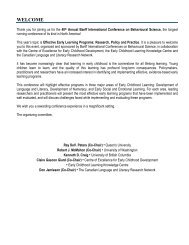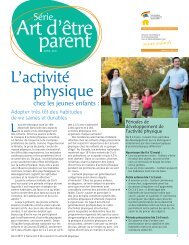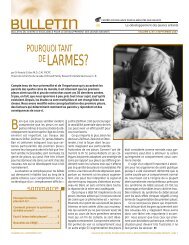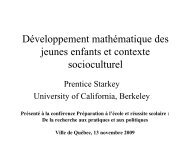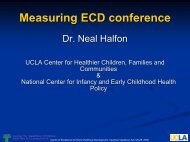Prevenir la violencia a través del aprendizaje en la primera infancia
Prevenir la violencia a través del aprendizaje en la primera infancia
Prevenir la violencia a través del aprendizaje en la primera infancia
Create successful ePaper yourself
Turn your PDF publications into a flip-book with our unique Google optimized e-Paper software.
3028 Tremb<strong>la</strong>y RE. Why socialization fails? The case ofchronic physical aggression. In: Lahey BB, Moffitt TE,Caspi A, eds. Causes of conduct disorder andjuv<strong>en</strong>ile <strong>del</strong>inqu<strong>en</strong>cy. New York: GuilfordPublications; 2003:182-224.29 Lacourse E, Nagin DS, Vitaro F, Côté S, Ars<strong>en</strong>eault L,Tremb<strong>la</strong>y RE. Prediction of early onset deviant peergroup affiliation: A 12 year longitudinal study.Archives of G<strong>en</strong>eral Psychiatry. 2006;63(5):562-568.30 Côté S, Vail<strong>la</strong>ncourt T, LeB<strong>la</strong>nc JC, Nagin DS,Tremb<strong>la</strong>y RE. The developm<strong>en</strong>t of physica<strong>la</strong>ggression from toddlerhood to pre-adolesc<strong>en</strong>ce: Anation wide longitudinal study of Canadian childr<strong>en</strong>.Journal of Abnormal Child Psychology.2006;34(1):71-85.31 Raymond M. Décrocheurs du secondaire retournantà l’école. Ottawa, ON: Statistiques Canada, Divisionde <strong>la</strong> Culture, tourisme et c<strong>en</strong>tre de <strong>la</strong> statistique <strong>del</strong>’éducation; Avril 2008. 81-595-M. Disponible sur:http://www.statcan.ca/francais/research/81-595-MIF/81-595-MIF2008055.pdf32 McCaul EJ, Donaldson GA, Co<strong>la</strong>darci T, Davis WE.Consequ<strong>en</strong>ces of dropping out of school: Findingsfrom high-school and beyond. Journal of EducationalResearch. 1992;85(4):198-207.33 Rothwell N, Turcotte M. The influ<strong>en</strong>ce of educationon civic <strong>en</strong>gagem<strong>en</strong>t: Differ<strong>en</strong>ces across Canada’srural-urban spectrum. Rural and Small Town CanadaAnalysis Bulletin. Vol 7. Statistics Canada. Catalogu<strong>en</strong>o.21-006-HIE. Avai<strong>la</strong>ble at:http://dsppsd.tpsgc.gc.ca/Collection/Statcan/21-006-X/21-006-XIE2006001.pdf ed; 2006:18.34 Canada Gd. Après l’école: résultats d’une <strong>en</strong>quêt<strong>en</strong>ationale comparant les sortants de l’école auxdiplômés d’études secondaires de 18 à 20 ans.Ottawa, ON: Ressources humaines et travail Canada/ Cat. no. LM2940793F; 1993.35 Vitaro F, Br<strong>en</strong>dg<strong>en</strong> M, Larose S, Tremb<strong>la</strong>y RE.Kindergart<strong>en</strong> disruptive behaviors, protectivefactors, and educational achievem<strong>en</strong>t by earlyadulthood. Journal of Educational Psychology.2005;97(4):617-629.36 Cairns RB, Cairns BD. Life lines and risks: Pathwaysof youth in our time. New York: Cambridge UniversityPress; 1994.37 Barker ED, Séguin JR, White HR, et al. Developm<strong>en</strong>ttrajectories of physical viol<strong>en</strong>ce and theft: re<strong>la</strong>tions toneuro-cognitive performance. Archives of G<strong>en</strong>eralPsychiary. 2007;64(5):592-599.38 Séguin JR, Ars<strong>en</strong>eault L, Boulerice B, Hard<strong>en</strong> PW,Tremb<strong>la</strong>y RE. Response perseveration in adolesc<strong>en</strong>tboys with stable and unstable histories of physica<strong>la</strong>ggression: The role of underlying processes. Journalof Child Psychology and Psychiatry. 2002;43(4):481-494.39 Ladd GW, Troop-Gordon W. The role of chronic peerdifficulties in the developm<strong>en</strong>t of childr<strong>en</strong>’spsychological adjustm<strong>en</strong>t problems. ChildDevelopm<strong>en</strong>t. 2003;74(5):1344-1367.40 Jimerson S, Ege<strong>la</strong>nd B, Sroufe LA, Carlson B. Aprospective longitudinal study of high schooldropouts examining multiple predictors acrossdevelopm<strong>en</strong>t. Journal of School Psychology.2000;38(6):525-549.41 Campbell S, B., Spieker S, Burchinal M, Poe MD,NICHD Early Child Care Research Network.Trajectories of aggression from toddlerhood to age 9predict academic and social functioning through age12 Journal of Child Psychology and Psychiatry andAllied Disciplines. 2006;47(8):791-800.42 Bail<strong>la</strong>rgeon RH, Zoccolillo M, Ke<strong>en</strong>an K, et al. G<strong>en</strong>derdiffer<strong>en</strong>ces in physical aggression: A prospectivepopu<strong>la</strong>tion-based survey of childr<strong>en</strong> before and after2 years of age. Developm<strong>en</strong>tal Psychology.2007;43(1):13-26.43 Archer J, Côté S. Sex differ<strong>en</strong>ces in aggressivebehavior: A developm<strong>en</strong>tal and evolutionaryperspective. In: Tremb<strong>la</strong>y RE, Hartup WH, Archer J,eds. Developm<strong>en</strong>tal origins of aggression. New York:Guilford Press; 2005.44 Côté S. Sex differ<strong>en</strong>ces in physical and indirectaggression: A developm<strong>en</strong>tal perspective. EuropeanJournal of Criminal Policy Research. 2007;13(3-4):183-200.45 Nagin DS, Tremb<strong>la</strong>y RE. Par<strong>en</strong>tal and early childhoodpredictors of persist<strong>en</strong>t physical aggression in boysfrom kindergart<strong>en</strong> to high school. Archives ofG<strong>en</strong>eral Psychiatry. 2001;58(4):389-394.46 Tremb<strong>la</strong>y RE, Nagin D, Séguin JR, et al. Physica<strong>la</strong>ggression during early childhood: Trajectories andpredictors. Pediatrics. 2004;114(1):e43-e50.47 Ke<strong>en</strong>an K, Shaw DS. The developm<strong>en</strong>t of aggressionin toddlers: A study of low-income families. Journalof Abnormal Child Psychology. 1994;22(1):53-77.48 Dionne G, Tremb<strong>la</strong>y RE, Boivin M, Lap<strong>la</strong>nte D,Pérusse D. Physical aggression and expressivevocabu<strong>la</strong>ry in 19 month-old twins. Developm<strong>en</strong>talPsychology. 2003;39(2):261-273.49 Br<strong>en</strong>dg<strong>en</strong> M, Dionne G, Girard A, Boivin M, Vitaro F,Pérusse D. Examining g<strong>en</strong>etic and <strong>en</strong>vironm<strong>en</strong>taleffects on social aggression: A study of 6-year-oldtwins. Child Developm<strong>en</strong>t. 2005;76(4):930-946.50 Caspi A, McC<strong>la</strong>y J, Moffitt T, et al. Role of g<strong>en</strong>otypein the cycle of viol<strong>en</strong>ce in maltreated childr<strong>en</strong>.Sci<strong>en</strong>ce. 2002;297:851-854.51 Widom CS. The cycle of viol<strong>en</strong>ce. Sci<strong>en</strong>ce.1989;16(244):160-166.52 Shaw D. Les programmes de souti<strong>en</strong> par<strong>en</strong>tal et leurimpact sur le développem<strong>en</strong>t socio-affectif desjeunes <strong>en</strong>fants. (2007) Dans: C<strong>en</strong>tre d’excell<strong>en</strong>cepour le développem<strong>en</strong>t des jeunes <strong>en</strong>fants (CEDJE).Encyclopédie sur le développem<strong>en</strong>t des jeunes<strong>en</strong>fants. Disponible <strong>en</strong> ligneh t t p : / / w w w . e n f a n t -<strong>en</strong>cyclopedie.com/pages/PDF/ShawFRxp-Par<strong>en</strong>ts.pdf.53 Dishion TJ. The family ecology of boys’ peer re<strong>la</strong>tionsin middle childhood. Child Developm<strong>en</strong>t.1990;61(3):874-892.54 Rubin KH. Par<strong>en</strong>ts of aggressive and withdrawnchildr<strong>en</strong>. In: Bornstein MH, ed. Handbook ofpar<strong>en</strong>ting, Vol 1: Childr<strong>en</strong> and par<strong>en</strong>ting. Hillsdale,NJ: Lawr<strong>en</strong>ce Erlbaum Associates; 1995:255-284.55 Belsky J, Jaffee SR. The multiple determinants of



